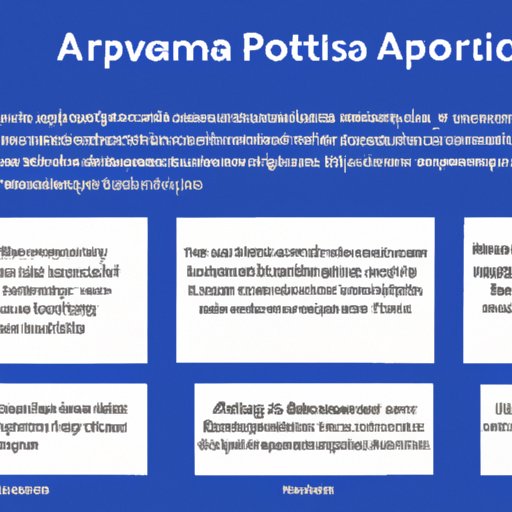Introduction
Robotic process automation (RPA) is an emerging technology that uses software robots or bots to automate mundane, repetitive tasks. It is a form of automation that has been gaining traction in recent years due to its potential to reduce costs, increase efficiency, and improve quality control. In this article, we will explore what RPA robotics is, the benefits it offers, a guide to implementing it in your business, the role of artificial intelligence, and real-world examples.

An Overview of RPA Robotics: What It Is and How It Works
RPA robotics is a type of automation technology that uses software robots or bots to automate mundane, repetitive tasks. By automating these tasks, organizations can save time and money, as well as free up resources for more strategic activities. The bots are programmed to mimic human behavior, such as entering data into a system, running reports, and generating documents.
The bots are designed to be flexible and able to adapt to changes in the environment. This means they can be used in different contexts and can be easily modified to fit different needs. Additionally, they can be integrated with other technologies, such as artificial intelligence (AI).
Exploring the Benefits of RPA Robotics
RPA robotics offers many benefits to organizations, including cost savings, increased efficiency, and improved quality control. Here are some of the key advantages of using RPA robotics:
Cost Savings
One of the main advantages of RPA robotics is that it can help organizations reduce costs by eliminating the need for manual labor. By automating mundane tasks, businesses can save money on salaries and overhead costs. Additionally, RPA robotics can help businesses streamline processes, which can further reduce costs.
Increased Efficiency
Another benefit of RPA robotics is that it can help organizations increase their efficiency. By automating tedious, repetitive tasks, organizations can free up resources that can be used for more strategic activities. Additionally, RPA robotics can help speed up processes, reducing the amount of time spent on mundane tasks.
Improved Quality Control
RPA robotics can also help organizations improve their quality control. By automating processes, organizations can ensure that all tasks are completed correctly and consistently. Additionally, RPA robotics can help organizations identify and address errors quickly, helping to reduce costly mistakes.

A Guide to Implementing RPA Robotics in Your Business
Implementing RPA robotics in your business can be a daunting task. To ensure a successful implementation, it is important to understand the process and develop a strategy. Here are some tips for getting started:
Identifying Opportunities for Automation
The first step in implementing RPA robotics is to identify opportunities for automation. Organizations should look for tasks that are repetitive and mundane, as these are prime candidates for automation. Additionally, organizations should consider how automation can help streamline processes and increase efficiency.
Choosing the Right Technology
Once opportunities for automation have been identified, the next step is to choose the right technology. Organizations should consider the capabilities of the technology and how it can be integrated with other systems. Additionally, organizations should consider the cost of the technology and any ongoing maintenance costs.
Developing a Strategy
Finally, organizations should develop a strategy for implementing RPA robotics. This includes setting goals, defining roles and responsibilities, and developing a timeline. Additionally, organizations should consider how to measure success and plan for any potential risks.

The Future of RPA Robotics: What To Expect
RPA robotics is still relatively new, but it is expected to become increasingly popular in the coming years. The technology is expected to experience increasing adoption, resulting in greater efficiency and a wider range of use cases. Additionally, RPA robotics is expected to become more sophisticated, thanks to advances in artificial intelligence.
The Role of Artificial Intelligence in RPA Robotics
Artificial intelligence (AI) is playing an increasingly important role in RPA robotics. AI-powered bots can not only automate mundane tasks, but can also learn from past experiences and adjust their behavior accordingly. Additionally, AI-powered bots can be used to enhance human capabilities, such as decision-making and problem-solving.
Understanding RPA Robotics Through Real-World Examples
To gain a better understanding of how RPA robotics is being used in the real world, here are some examples of organizations that are using the technology:
Tesla Factory Automation
Tesla is using RPA robotics to automate the production of its electric vehicles. The company has implemented bots to perform tasks such as welding and painting, resulting in increased efficiency and improved quality control.
Automating Financial Processes at JPMorgan Chase
JPMorgan Chase is using RPA robotics to automate financial processes such as loan origination, customer onboarding, and account opening. The company has seen a reduction in processing times and an increase in accuracy.
Automation of IT Tasks at Amazon
Amazon is using RPA robotics to automate IT tasks such as software deployments, server updates, and system monitoring. The company has seen a reduction in errors and an increase in efficiency.
Conclusion
Robotic process automation (RPA) robotics is an emerging technology that uses software robots or bots to automate mundane, repetitive tasks. It can help organizations save time and money, as well as increase efficiency and improve quality control. In this article, we explored what RPA robotics is, the benefits it offers, a guide to implementing it in your business, the role of artificial intelligence, and real-world examples.
RPA robotics is expected to become increasingly popular in the coming years, as more organizations recognize the potential of the technology. As organizations continue to explore the possibilities of RPA robotics, it is likely that the technology will become even more sophisticated and powerful, thanks to advances in artificial intelligence.
(Note: Is this article not meeting your expectations? Do you have knowledge or insights to share? Unlock new opportunities and expand your reach by joining our authors team. Click Registration to join us and share your expertise with our readers.)
